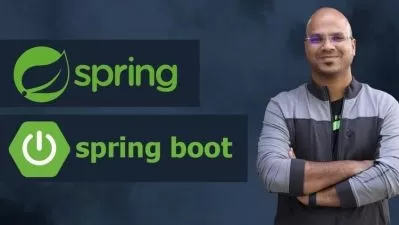NEW: Spring Boot 3 Securing Your Application with JWT Token
BOUALI Ali
1:58:37
Description
Spring Boot 3 + Spring Security 6 - JWT Authentication and Authorisation [NEW] [2023]
What You'll Learn?
- Implement user authentication and authorization using Spring Security
- Encrypt user passwords using BCrypt
- Implement role-based authorization with Spring Security
- Use JSON Web Tokens (JWT) to provide a secure, stateless method of authentication
- ntegrate JWT into a Spring Boot application
Who is this for?
More details
DescriptionAre you looking to secure your Spring Boot applications and keep them safe from unauthorized access? Look no further! Our course, "Spring Security with JWT: Protect Your Applications from Unauthorized Access," is the perfect solution for you.
In this course, you'll learn everything you need to know about using Spring Security and JSON Web Tokens (JWT) to secure your applications. We'll start by teaching you the basics of Spring Security and how it can be used to authenticate and authorize users in your application. From there, you'll learn how to implement JWT to provide a secure, stateless method of authentication.
With our step-by-step instructions and hands-on exercises, you'll gain the knowledge and skills you need to confidently secure your Spring Boot applications. Plus, with lifetime access to the course materials, you can revisit the lessons anytime you need a refresher.
Don't let unauthorized access threaten the security of your applications. Enroll in "Spring Security with JWT: Protect Your Applications from Unauthorized Access" today and take the first step towards safeguarding your valuable assets.
A JSON Web Token (JWT) is a compact, URL-safe means of representing claims to be transferred between two parties. The claims in a JWT are encoded as a JSON object that is digitally signed using JSON Web Signature (JWS).
A JWT consists of three parts: a header, a payload, and a signature.
The header typically consists of two parts: the type of the token, which is JWT, and the signing algorithm being used, such as HMAC SHA256 or RSA.
The second part of the token is the payload, which contains the claims. Claims are statements about an entity (typically, the user) and additional data. There are three types of claims: registered, public, and private claims. Registered claims are a set of predefined claims which are not mandatory but recommended, to provide a set of useful, interoperable claims. Some of the registered claims are:
iss (issuer) claim identifies the principal that issued the JWT.
sub (subject) claim identifies the subject of the JWT.
aud (audience) claim identifies the recipients that the JWT is intended for.
exp (expiration time) claim identifies the expiration time on or after which the JWT MUST NOT be accepted for processing.
Public claims are claims that are defined in the IANA JSON Web Token Registry or are public by nature. Private claims are custom claims created to share information between parties that agree on using them.
The third part of the token is the signature, which is used to verify that the sender of the JWT is who it claims to be and to ensure that the message wasn't changed along the way.
To create the signature part you have to take the encoded header, the encoded payload, a secret, the algorithm specified in the header, and sign that. For example if you want to use the HMAC SHA256 algorithm, the signature will be created in the following way:
HMACSHA256( base64UrlEncode(header) + "." + base64UrlEncode(payload), secret)
The final JWT will be three base64-URL strings separated by dots, which can be easily passed in HTML and HTTP environments, while being more compact when compared to XML-based standards such as SAML.
Who this course is for:
- Students
- Beginners
- Mid level
Are you looking to secure your Spring Boot applications and keep them safe from unauthorized access? Look no further! Our course, "Spring Security with JWT: Protect Your Applications from Unauthorized Access," is the perfect solution for you.
In this course, you'll learn everything you need to know about using Spring Security and JSON Web Tokens (JWT) to secure your applications. We'll start by teaching you the basics of Spring Security and how it can be used to authenticate and authorize users in your application. From there, you'll learn how to implement JWT to provide a secure, stateless method of authentication.
With our step-by-step instructions and hands-on exercises, you'll gain the knowledge and skills you need to confidently secure your Spring Boot applications. Plus, with lifetime access to the course materials, you can revisit the lessons anytime you need a refresher.
Don't let unauthorized access threaten the security of your applications. Enroll in "Spring Security with JWT: Protect Your Applications from Unauthorized Access" today and take the first step towards safeguarding your valuable assets.
A JSON Web Token (JWT) is a compact, URL-safe means of representing claims to be transferred between two parties. The claims in a JWT are encoded as a JSON object that is digitally signed using JSON Web Signature (JWS).
A JWT consists of three parts: a header, a payload, and a signature.
The header typically consists of two parts: the type of the token, which is JWT, and the signing algorithm being used, such as HMAC SHA256 or RSA.
The second part of the token is the payload, which contains the claims. Claims are statements about an entity (typically, the user) and additional data. There are three types of claims: registered, public, and private claims. Registered claims are a set of predefined claims which are not mandatory but recommended, to provide a set of useful, interoperable claims. Some of the registered claims are:
iss (issuer) claim identifies the principal that issued the JWT.
sub (subject) claim identifies the subject of the JWT.
aud (audience) claim identifies the recipients that the JWT is intended for.
exp (expiration time) claim identifies the expiration time on or after which the JWT MUST NOT be accepted for processing.
Public claims are claims that are defined in the IANA JSON Web Token Registry or are public by nature. Private claims are custom claims created to share information between parties that agree on using them.
The third part of the token is the signature, which is used to verify that the sender of the JWT is who it claims to be and to ensure that the message wasn't changed along the way.
To create the signature part you have to take the encoded header, the encoded payload, a secret, the algorithm specified in the header, and sign that. For example if you want to use the HMAC SHA256 algorithm, the signature will be created in the following way:
HMACSHA256( base64UrlEncode(header) + "." + base64UrlEncode(payload), secret)
The final JWT will be three base64-URL strings separated by dots, which can be easily passed in HTML and HTTP environments, while being more compact when compared to XML-based standards such as SAML.
Who this course is for:
- Students
- Beginners
- Mid level
User Reviews
Rating
BOUALI Ali
Instructor's Courses
Udemy
View courses Udemy- language english
- Training sessions 35
- duration 1:58:37
- Release Date 2023/03/02











